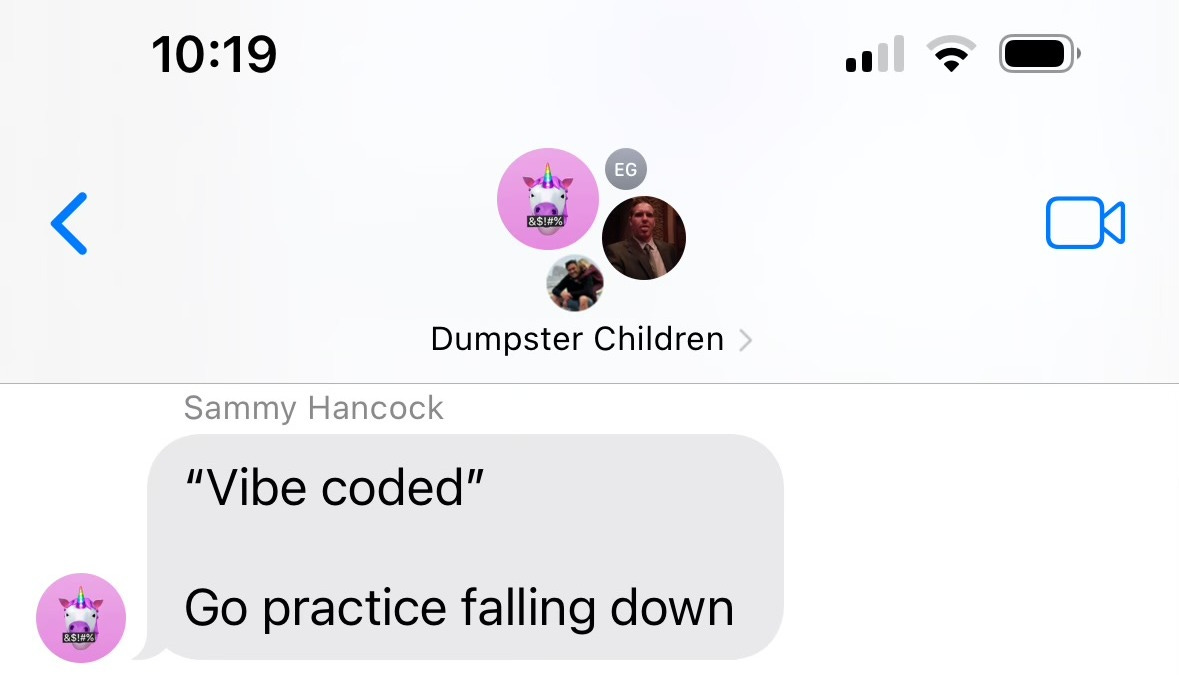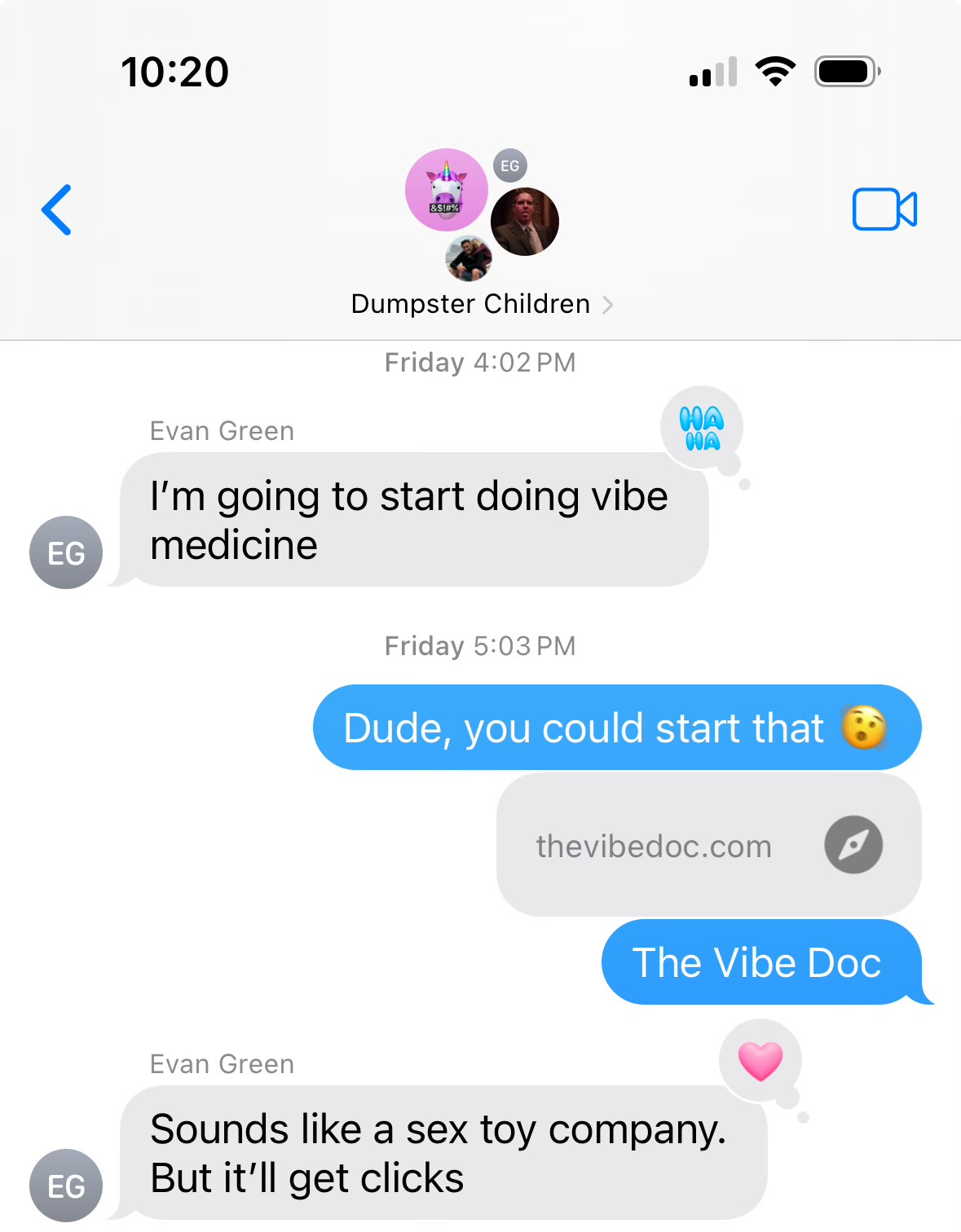The Unadulterated Magic of Vibe Coding
A Caffeinated PM's Guide to AI-Powered Creative Liberation
Holy shit fam, we've finally done it. After decades of PMs drowning in the bureaucratic hellscape of documentation, user stories, and stakeholder theater, we now have the nuclear option: just build the damn thing ourselves.
Welcome to Vibe Coding, the beautiful bastard child of AI tooling and PM desperation. We are having a cultural moment where the idea people are saying “fuck you” to the bloated apparatus of modern product development and owning our destinies. It’s time to join the revolution, comrades.
The process is intoxicating:
Cannabis-induced shower thought → Working prototype in hours
No budget approvals
No resource allocation meetings
No stakeholder buy-in theater
The Obsolescence of the Middleperson
The tragedy of the modern PM is that prior to RFN (right fucking now), to bring a concept to life, our primary weapons were decks, documentation, user stories… tedious to write, boring AF to read. We were consigned to the role of professional translator, converting ideas into corporate speak, then begging engineers and designers to pretty please – make it real.
It was a system perfectly designed to dilute every bold idea through seven layers of interpretation and budget justification.
Lucky for us, AI tools have essentially made the entire product development pipeline... optional. Vibe Coding tools are weapons of mass disruption aimed squarely at the traditional "let's have a meeting about the meeting" approach to building things.
You now have the option of cutting out the middle fuckers (sorry/not-sorry devs and designers). They were going to misinterpret your idea or feel the need to put their own spin on it anyway. Okay, yes, fuck you all, sometimes your dev/design colleagues take the concept to the next level… but just as often they “don’t get it,” and fuck the entire thing. Turns out, ideas are hard to communicate with words; Human OS does better at parsing experiences.
Instead of spending your time as an over-tired PM on convincing other people to bring your idea to life and risk them fucking it up, you can now go straight from “idea you had while smoking pot and walking the dog” to “working prototype,” in a few hours. Brothers and sisters in product, welcome to the future.
Skip Straight to Show, Don't Tell
Vibe Coding is a godsdamn corporate superpower: instead of convincing people with words, you show them working software. Prototypes are corporate truth serum; they cut through opinion and politics to reveal what actually matters.
Stakeholders who would never read your 47-slide deck or 6-page doc will spend twenty minutes clicking through your prototype. Customers who can't articulate their needs will immediately tell you what works and what doesn’t when they can actually use the bloody software. Prototypes get execs in a tizzy and make them want to open their checkbooks. Prototyping is power. “Win through actions, not argument,” counsels Robert Greene in his corporate politics survival guide, The 48 Laws of Power.
Everyone's a Product Person Now
And of course, developers and designers should be doing this shit too. Why should PMs have all the fun circumventing bureaucracy? Engineers tired of building features that they think are doomed to fail can prototype their own ideas. Designers exhausted by stakeholders who 'just want it to pop' can build their vision directly.
When everyone Vibes, the best ideas win regardless of who had them or what their job title says. PMs lose their monopoly on product vision. Developers get more agency. Designers get to pitch bolder, less watered-down ideas.
When To Vibe
Let's be brutally honest about what this magical AI wizardry is actually good for, because the last thing we need is another PM thinking they can ship production code to millions of users because they sweet-talked Claude into building a decent-looking prototype.
What Vibe coding is fucking fantastic for…
✓ Prototype Theater – Building clickable demos to convince stakeholders that your shower thoughts deserve actual engineering resources.
✓ Internal Tool Badassity – Have janky spreadsheets and manual processes that make everyone miserable but never get prioritized? Vibe code that shit. Build the productivity app your team actually needs. For my day job at PODS, I Vibe Coded a searchable Research Dashboard in a weekend, making it possible to actually find info and insights.
✓ Personal Web Presence – Want a website that doesn't scream "I used a Squarespace template?" Vibe coding lets you build something custom without learning CSS or begging your designer friend for favors.
When Vibe coding becomes self-immolation…
ⓧ Production code at scale – AI-generated code running your company's payment system is how you become a cautionary tale/internet meme. Just check out the recent clusterfuck in which a Replit AI agent deleted a user's entire production database. Rapid prototyping does not equal real software engineering; leave that to the mega-nerds.
Okay, enough foreplay, here’s a short guide on how to Vibe →
Step 1: Pick your Vibe Coding Weapon of Choice
Pick a tool and stick with it so you can get good at. Bouncing around is going to make you half-assed at everything.
My choice is Lovable. But there are a bunch of good options, you likely know the names: Cursor, Bolt, Replit, Claude Artifacts, and v0.
Step 2: Write the Prompt
If you read my handy-dandy guide to prompting, you know I’m a massive fan of “Meta-Prompting,” which is the cool-kid way of saying, get AI to write the prompt for you. Fire up Claude/ChatGPT/etc, and use something like:
Hi, can you please help me with a prompt for an AI Software Generation tool? I want to create <core concept>, with <key requirements>, and <design/style considerations>. Before you create the prompt, please ask any follow-up questions you need to help get it right.
Step 3: Embrace the One-Shot Philosophy
Copy your prompt into your Vibe Coding tool of choice and check out the results. Next, ask yourself: Did I more or less “one-shot” the idea? If your first version turned out awesome, great, now iterate the fuck out of it.
If your first prototype is wildly off-target, delete and restart rather than iterate. Traditional product development taught us to work through "iterative improvement." Vibe Coding teaches us that starting fresh is faster than building on a broken foundation.
Step 4: Discover Multiplayer Creative Flow
Grab a colleague, invite them to your project, and go multiplayer. Vibe Coding lends itself to two people jamming. It is an epic amount of fun that will make you feel bad for anyone who doesn’t get to use words like magic spells to bring ideas to life. Two people tag-teaming AI prompts in real-time, it is iteration at the speed of ADHD.
Here’s how it works:
Player 1: Sends a prompt → "Let’s make those labels bold.”
Player 2: Prepares the next prompt while the AI is working
AI: Delivers Player 1’s prompt
Player 2: Sends the next prompt → “Let’s add user authentication.”
Player 1: Prepares the next prompt while the AI is working
Rinse & Repeat
Doing this shit is rapid fucking fire iteration and unadulterated creative goodness. Grab a favored colleague and go to town.
Step 5: Share the Vibes
Share your creation. Send it to stakeholders and ask them to cut you a check to fund your idea. Bribe customers with Amazon gift cards and set up a usability test. Send it to your colleagues to make them jealous that you are a 10x doper PM get their feedback.
Send it to your non-tech friends, but be prepared for ridicule.
Step 6: Pour Yourself a Cocktail
Have a drink. Go microdose, or better yet, macrodose. In a few short hours, you went from fuzzy idea to “holy fuck this is cool.”
Bonus Section: My Personal Vibes
My Recent Vibes:
PM8 Ball Website: When the roadmap is unclear, let fate decide.
Focus Pocus: (Still in super early concept phase) A playful productivity ritual that acts as a charm against distraction, people-pleasing, and creative overwhelm.
PODS Research Dashboard: Biz/Customer insights at a glance + searchable documentation.
PODS Pricing & Review Map: A map that reveals average pricing, location-specific reviews, and origin/destination insights for moving customers.
PODS Vibe FAQs: Enhanced FAQs that support answers by pulling in snippets from customer reviews.
PODS AI Workspace: Research Chatbot plus example AI-powered internal tools. My fellow PMs and I built this in 6 hours during a hackathon.






Great article! Really fired me up to go build instead of paper push. Lol
Any particular reason you chose Lovable over others?